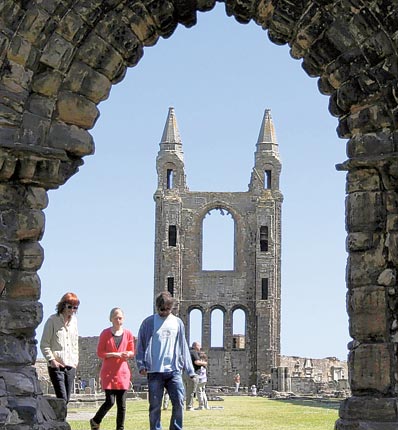Brian Viner: It may be heresy, but St Andrews is more than the Old Course
The Last Word

Trying in heavy rain to keep your notebook dry and your ballpoint fully operational, while water is cascading into your waterproofs via the back of your neck, is not the hardest way of earning a living, but nor, at various stages of the Open Championship yesterday, did it seem like the easiest.
Out beyond the 11th green, which is the point of the Old Course furthest from the shelter of the vast tented village, and where the vertical wetness was somehow compounded by horizontal wetness in the bleak, flat form of the adjacent Eden estuary, it was even possible to feel slightly sorry for oneself. Yet turning back towards the distant auld grey toun, I felt my heart lift, as it always does at the sight of the spires and towers of St Andrews. This was where I spent four happy years as an undergraduate, improving my golf handicap and even retaining the odd bit of information about the Revocation of the Edict of Nantes.
Such is my affection for the old place that when the Open takes place here I always feel a little stab of indignation on behalf of the Protestant martyrs burnt at the stake, the recalcitrant Catholics imprisoned in the castle's "bottle" dungeon, the archbishops driven from their palaces, the pilgrims conned into buying fragments of St Andrew's bones, all within a couple of John Daly drives from the Old Course. The people who flock here for the Open don't know or care about all that stuff, and there is no pressing reason why they should, but I can't help lamenting the fact that the bar of the Rusacks Hotel is the furthest some of them venture into one of Britain's most perfectly preserved medieval towns. As for the bits that aren't so well preserved, the vast cathedral and the castle clinging to rocks hard by the North Sea, they are about the most evocative, atmospheric ruins I know, yet I doubt whether more than one in 50 of the huge crowds tramping across the Old Course this week, not to mention the golfers they are here to watch, are even aware they're there.
They should be, really, because the town and the most venerable of its golf courses are umbilically connected. If he hasn't already, young Rory McIlroy should go to the cathedral and pay his respects at the grave of "Young" Tom Morris, four-times Open champion who died in 1875 aged just 24, supposedly of a broken heart following the death of his wife in childbirth, but possibly of a perforated liver after pickling his sorrows in drink. Moreover, in purely physical terms, the unique townscape can enhance a golfer's score. All the St Andrews-based caddies here know which landmark to pick out on the horizon, when giving their golfer a line over what, on first acquaintance, can look less like the most famous golf course on earth and more like the surface of the moon.
Anyway, on Thursday evening, after a pint or two, possibly three, I took matters into my own hands and introduced my Independent colleagues to the letters "PH", stamped into the cobbles outside St Salvator's Chapel to mark the spot where Patrick Hamilton, a Lutheran reformer, was publicly incinerated on 29 February 1528. It is said that the wind and rain were so bad that day that poor old Hamilton took six hours to die, which brings a degree of perspective to the hardship caused by a soggy notebook and malfunctioning pen.
A real golfing green master
Earlier this week, elsewhere in these pages, I wrote a column extolling the virtues of golf. I was expecting a backlash from those who consider the game practically synonymous with the Third Reich, and I was not disappointed. One outraged blogger deemed me "shallow" and "dim-witted". Well, I am going to drive them to their keyboards again by asserting that golf can be a wonderful thing for the environment.
A few weeks ago, a friend of mine, Chris Walsh, died very unexpectedly at the age of 54. Chris loved golf and nature in equal measure; playing with him at his home course, Walton Heath in Surrey, could be uplifting and exasperating at the same time, because he would often shoot off into a copse to fill his bag with wild mushrooms or get sidetracked by a glimpse of a rare woodland bird, which he could always identify. He entwined these two passions by helping to produce a pamphlet called "Caring For Walton Heath", which has become the standard text, used all over the world, on how a golf club can improve the land on which it sits by increasing biodiversity and, in the particular case of Walton Heath, by regenerating an important area of lowland heathland, reviving many species of plants and bringing back woodlarks and other wildlife. Chris will be sorely missed, but he leaves a great legacy.
Heskey quits – but will we notice?
Emile Heskey retired from international football this week. He was never the plank that some people thought, but the fact remains that in 62 appearances as a forward for England he scored only seven goals. And so his retirement rather brings to mind Dorothy Parker's waspish line on being told that taciturn US President Calvin Coolidge had expired: "How could they tell?"

Join our commenting forum
Join thought-provoking conversations, follow other Independent readers and see their replies